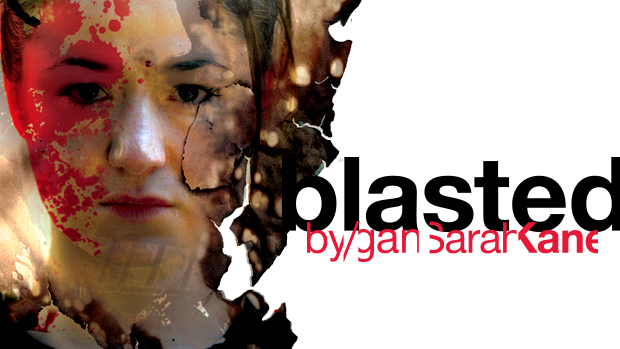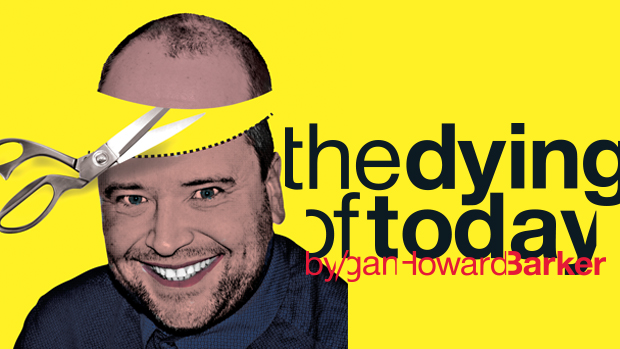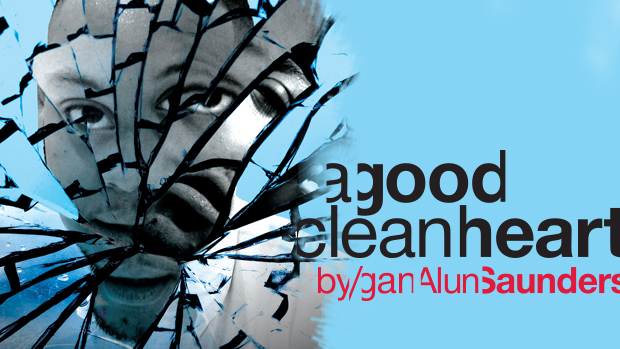
Life in Close Up: The Other Room’s First Season Overview
Now that The Other Room’s opening season has reached its close, Kate Wasserberg and her team can breath their first sigh of relief after a hugely successful critical and public response to three very unusual plays. Spatially, with just forty-four seats, it was an apt move to shape the first season around the intimate experience that The Other Room offers as the performance sits on top of you wherever you are situated. As a final round up to reflect on the ‘Life in Close Up’ season’s antics and audience appraisals, I had the opportunity to catch up with artistic director Kate Wasserberg and Alun Saunders, the writer of ‘A Good Clean Heart’ to address those niggling questions and observations that struck me during these performances.

Sarah Kane’s Blasted (1995)
It was bold choice by Kate and the The Other Room team to open the season and the theatre itself with a play that is engulfed in controversial and challenging criticism. The late 90’s reviews had originally brandished Sarah Kane’s Blasted as a sordid and immature piece of writing that for all intensive purposes was written to shock. Despite many of these accusations being revised, launching the ‘Life in Close Up’ season with Blasted instantly stimulated debate and got people talking about what the The Other Room in Cardiff was doing. This was my first piece as a young critic and I had no idea what to expect. After briefly flitting over a Wikipedia synopsis, I initially struggled to grasp the script’s bizarre intentions. However, after seeing it performed as a play rather than reading out a list of violent gimmicks, it became clear that these online summaries are hugely damaging to the play’s reputation; the impact lies within the performance. Despite its controversial standpoint, The Other Room’s production was given a 4* rating by The Guardian and overall it excelled in its reviews from critics who were somewhat shaken but left in awe.
Blasted- A Close up with Kate Wasserberg (Artistic Director)
Q: Recently, with Sherman’s ‘Iphigenia in Splott’ and Chapter’s more ambitious programme, Cardiff theatre seems to have dropped the conservative barrier but a script of this intensity has very rarely been performed on Welsh soil. This was out of Cardiff’s theatrical comfort zone. You clearly had confidence in the script and the fantastic cast. Were you concerned about the play’s notoriety and about challenging the relatively safe expectations of theatre that Cardiff sits comfortably with or did you anticipate that this would fuel its success? Despite the fact that I cannot pretend to have necessarily enjoyed watching Blasted, it was an unforgettable experience and one that has successfully conjured a huge critical response.
Kate: I have always thought of Blasted as a really honest, heartfelt play. Of course I was aware that it is shocking in places and yes that was a conscious decision, to offer up something new. But the main motivation was not so much a response to the arts scene but as a way to attempt to articulate the world as I was experiencing it at the time, not as wholly dark but certainly with cruelty and pain and callousness out there, on the news. The critical response was really varied, and the first few reviews that came out, they really disliked the show and that was quite a raw experience – I can’t remember the last time I have felt so exposed, the cast were giving these incredibly courageous performances and we hadn’t had long to rehearse it really so I felt very protective. But that’s part of doing this play, and approaching it the way we did – head on with no deliberate style. It’s not for everyone and you have to accept that. Of course then more reviews came out and some people did really like it and that was lovely and the audience started to feedback to us and we grew in confidence, but all responses are perfectly valid and that rawness is part of the experience, I think.
Q: Initially, I struggled to distinguish what exactly had bothered me about the play which was odd because the shocking violent junctures are overtly clear and it surprised me that they were not my primary concern. It was the moments of sympathy embedded in the horror, Kate’s uncontrollable laughter and the desperate cry for help read through Ian’s eye contact during the rape. It was the fact that there is never an entire loss of humanity which as an audience member is what you crave in order to dismiss what you have witnessed. Were you specifically conscious about how these moments were going to be directed?
Kate: I think I was, yes. Our starting point as a company was to be as real as possible – to ask, but what if this really was happening? It sounds a bit trite to say it now but in a play that is known for being shocking, it was important for us that the people were complex and human and real. Christian, Louise and Simon were all totally fearless about allowing themselves to go to some very difficult places emotionally and that did take a toll on them at times, but I think they all felt like we were engaged in something quite special and it was worth the vulnerability they felt.
Q: I am sure, particularly with this play, you witnessed a whole spectrum of reactions as people came out of The Other Room. Is there a specific response that stands out to you?
Kate: It was a bit odd in previews – perfectly content, happy people came in and shaken, crying people came out and I genuinely thought, my god, what are we engaged in here? Why do that to people? But of course to be moved is wonderful, even when it’s dreadful. I remember a group early on who really laughed at the jokes, right through to the end, they were wonderful. And an actor friend of mine who literally couldn’t speak, she had to call me the next day. But that’s the play – that’s Sarah Kane and her brilliance. We just tried to do her justice really.

Howard Barker’s The Dying of Today (2008)
After the hype of the first production, expectations were high for the second play in the series, Howard Barker’s The Dying of Today. Inspired by Thucydides’ account of the destruction of the Sicilian expedition during the Peloponnesian War, the play is constructed from that anxiety induced moment of inevitability, considering the worst case scenario in order to deduce how we process the phenomenon ‘bad news’. This was an equally challenging script for entirely different reasons. Barker’s play is stripped of distractions; its plot can be summarised by one line. To keep an audience attentive when the play is entirely based around a conversation with two people in such a mundane environment is a challenge for any director and two man cast.
The Dying of Today- A Close Up with Kate
Q:When I came to see this play, I distinctly remember that I still had half a drink left after the production came to a close. I was immediately drawn into the performance. It almost had a hypnotic effect on me and I think that had a lot to do with the narrative’s rhythmic pace and the fluidity of Leander Deeny and Christian Patterson’s interactions. How did you initially approach this script, was maintaining the momentum a high priority?
Kate: Definitely. We slowed right down in rehearsal to get the detail in but we always had our eye on pace and the confidence with which the ideas develop. It’s acrobatics in some ways, part of the joy is watching them leap from one idea to the next without stopping. Dneister (Leander Deeny) talks for seven minutes without stopping at the beginning of the play and that in itself; to talk ceaselessly and hold the attention of those listening, is a daring feat, especially when the ideas are so complex. Then the barber (Christian Patterson) joins and seems at first to be much simpler and slower but he very quickly builds his own pace and the whole show feels almost like a running race, exploding into physical action with the destruction of the shop.
Q: When the material that is being performed in front of you is as intense as Blasted, the space suddenly becomes very theatrically claustrophobic but for The Dying of Today, the chess board floor manipulates the size of the performance area and it feels deceptively bigger. Has it been a challenge to make the best of such a small space? In this case, what inspired the retro fifties salon? I loved the concept of the audience being the reflection of what we were watching as we sat waiting in anticipation for the news ourselves.
Kate: I definitely wanted the space to feel radically different for each show in the season and for it to be as exciting to walk into The Dying of Today as it was for Blasted, when the audience were seeing the theatre for the first time since the conversion. The 1950’s feel was about tying to distil the essence of a barber’s – a sort of reference that everyone would recognise. We tried to references various time periods throughout to stop the play feeling ‘set’ in a time or place but we also really wanted it to feel like a real shop, that was very important, that these enormous ideas unfolded in this very prosaic environment. But it had a bit of romance too, which was partly about searching for a bit of softness after the rawness of Blasted.

Alun Saunders’ A Good Clean Heart (2015)
The final play in the season was a newly commissioned bilingual work by Alun Saunders, a Welsh writer from Neath who trained as an actor at the RWCMD. A Good Clean Heart addresses a number of challenging questions about our cultural and personal identity but this is a truly unique piece of theatre for its ambitious and playful engagement with language. The play follows the story of two brothers raised in different cultures and familial environments; Hefin, adopted in Wales, well educated and a first-language Welsh speaker and Jay his older brother now living in London with his biological mother who they were originally taken away from. When Hefin is finally told on his eighteenth birthday of a sibling who has been reaching out to him, in a moment of spontaneity he initiates the long awaited meet where the pair struggle to come to terms with the years they have lost. Along with the discovery of his English roots, Hefin is introduced to his brother at a rather inconvenient time with the police waiting for an opportunity to bring Jay back in. The reunited family home is thrown into chaos where mother and sons are forced to make decisions that will impact the rest of their lives.
A Good Clean Heart- A Close Up with Alun Saunders
Q: Firstly, llongyfarchiadau on the incredible success that you have had with ‘A Good Clean Heart’. You must be thrilled with its critical reception?
Alun: Diolch! Thrilled is definitely one of the words… It’s a pretty overwhelming thing pouring your heart into a play without actually knowing how people are going to react. Did I say ‘overwhelming’? I mean terrifying. I imagine even seasoned Writers find it scary putting their work out there for public consumption as they’re under a different sort of pressure – the pressure to ‘keep up the good work’. For me, writing my first full-length play, I wanted to see whether what I had to say, and how I choose to say it, had a place in that public arena. The public and critical reception has absolutely spurred me on to knuckle down and write more. I’m really grateful.
Q: When you were addressing the notion of identity, it came across as a very fluid concept. I loved the intricate ways that this was incorporated into the script with James Ifan and Dorian Simpson jumping into the role of their mother and her boyfriend, drawing out that play on identity crisis. Whilst a national identity is a necessary central focus of the script, were you conscious to avoid restricting the definition of identity?
Alun: Abso-blinkin’-lutely. Having done a good bit of research into how people felt (and how strongly they felt) about their own ‘national identity’, I got such a varied response – some people aren’t bothered at all by it, where some people feel that it absolutely defines who they are. The important thing for me is that people are unique; stereotypes exist, but always with an element of contradiction (I’ve actually been called “a boy full of contradictions” myself). Whilst we constantly try to ‘order’ and categorise other people in order to help ourselves sort the ‘friendly /attractive/ positive’ from the ‘unfriendly/unattractive/negative’, nobody can decide our identity except ourselves. It was important that the characters of Hefin and Jay had a strong identity – even if that changed during the play – and that the audience were allowed to come to their own conclusions.
Q: Finally, in addition to the demanding technical work needed to create that bilingual accessibility, there was also a lot of visual play on language to the point that the words were literally bouncing of the walls. Was the animation of language and the bringing language to life something you enjoyed physically constructing?
Alun: From quite early on in the development of A Good Clean Heart, Kate Wasserberg and Mared Swain the plays director and I had discussions about the technical possibilities of this play. It’s been such a huge collaboration of ideas and skills to bring what was eventually seen to life, and I just feel honoured that so many people’s hard work created this success. For my part, I needed to create characters which the actors (and subsequently, the audience) could believe in, and a story and dialogue to channel that. I was always conscious, whilst writing, of the technical possibilities, so I was interested to see how we could bring a letter, an email and an online chat to life on stage, but the focus was always on where the story was going. Especially by Draft 14…
Kate: Huge praise is due to Zak Hein, who designed the animation, including the subtitling. He worked with Mared to create an incredibly bold visual language for the play that made the bilingualism a joy and also made the show very youthful. I think it worked brilliantly.
Alun: As a Playwright, writing my first full-length play under Kate and Mared’s mentoring has been invaluable. I’ve been pushed to the limits (and beyond) of what I thought I could manage, but seeing the end result has been worth every last blistered typing finger, every tear and 4am coffee. Had I given up four or five drafts ago then my life may, theoretically, have been ‘easier’, but the play we’d have ended up with would have been much weaker for it. I’m really grateful to those whip-cracking slave-drivers for believing in me, and for pushing me to get where we all wanted – only then could we justify the whole team’s hard work. Now to decide where we take it next…
A Final Word on the Season’s success…
Q: The Other Room has clearly hit Cardiff by storm, you must be very happy with the overall response to the first season?
Kate: Of course, we are and incredibly touched and grateful that so many people have supported the project – by coming to the shows, spreading the word and bringing people along. We are so proud to be part of this fantastic city and hope to continue to be worthy of our brilliant audience.
Q: What can we expect next, are there big plans in the pipeline?
Kate: We are putting the finishing touches on our next season and I’m deep into programming 2016. Some very exciting plans and a new way of working – we’ll keep you posted!
The Other Room will be hosting its first Young Arts Festival from 18-20th June where young talents will be showcased through a series of short plays written and performed by all those participating in the week’s festivities. For more information visit: http://www.otherroomtheatre.com/en/whats-on/current-productions/
A huge thank you to Kate and Alun for taking time out of their busy schedules for Young Critics.
 (4 / 5)
(4 / 5)




